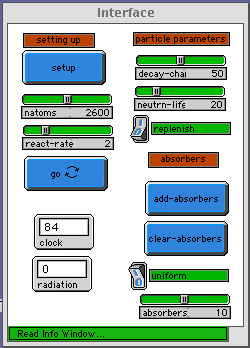
WHAT IS IT? ------------ This model simulates a nuclear reactor. Atoms decay at random and emit two neutrons each. The neutrons travel a certain distance and/or collide with other atoms, causing them to decay and emit neutrons in turn. Absorbers can be placed into the reactor, simulating control rods. HOW TO USE IT ------------- Under "Setting Up" set the initial number of atoms (NATOMS slider), the speed of the simulation (SIM-SPEED slider), and press the SETUP button. You will see a randomly spread collection of blue particles (atoms), and a yellow border on the outside. This border's function will be discussed in a moment. Press the GO button. You will see nothing at first, but eventually, an atom will decay into two neutrons (red), that begin to travel in random directions. This activity will be recorded by the plot "Natoms, Nneutrons vs. Time", which counts the number of atoms at a given time (blue) and the number of neutrons (red). Look at plot 2, "Radiation vs. Time". This measures the number of neutrons hitting the yellow border, which is sort of a Geiger counter. The radiation rate is also displayed on the meter on the Interface. While the reaction is running, press the ADD ABSORBERS button under "Absorbers". You will see a random spread of yellow rectangles. When a neutron hits an absorber, it disappears. Notice that the border on the outside is also yellow. The border, therefore, has the additional function of being an absorber. THINGS TO NOTICE ---------------- -Look at the "Natoms, Nneutrons" plot. What is the shape of the atom curve (blue)? The neutron curve (red)? Is there a relationship? -Compare the neutrons curve with the radiation curve in plot 2. -Watch one atom decay, counting the clock ticks on the CLOCK meter. How long does it take one atom to decay? -How long does it take for the reaction to be completed with many atoms? THINGS TO TRY ------------- -Turn on the "Replenish" Switch Under "Particle Parameters". This causes a new atom to be generated each time an atom decays, thus creating an endless surplus of fissionable material. Look at both plots now. What is happening to the radiation curve (i.e. what is it doing on average)? -Change the NEUTRN-LIFE slider under "Particle Parameters" to 1 and turn on the simulation. What is the average value of the radiation? -Press CLEAR ABSORBERS, turn on the UNIFORM switch under "Absorbers", and press ADD-ABSORBERS. What does the absorber distribution look like now? Clear the absorbers, change the ABSORBERS slider to a higher value, and add absorbers again. Turn on the reaction. -Set number of atoms to a value below 1000, and the neutron life to around 8. Did a chain reaction occur? Explore the idea of "critical mass", or "critical density" in terms of NEUTRN-LIFE and NATOMS. -Play around with the number of absorbers, decay chance, and neutron life to see if you can get a stable reaction. Change the parameters so that the radiation stays around a certain value. -There are many possible combinations of parameters that produce a steady chain reaction. Are there some that are very sensitive to slight changes -- a dangerous situation! -- and some with a lot of latitude? EXTENDING THE MODEL ------------------- -The model only contains one kind of radioactive atom. Try adding a different kind of atom, with, say, 3 neutrons on decay. -Add a slider for the number of neutrons emitted during decay. Try having a random number of neutrons instead. -The heading of neutrons upon decay is random. Try giving it a range below 360 degrees. -To what real mechanism in particle physics does each of these parameters correspond? Do you think this model is "realistic"? Do some research on nuclear reactors and see if the model can be made to correspond more exactly to what really takes place. STARLOGOT FEATURES -------------------